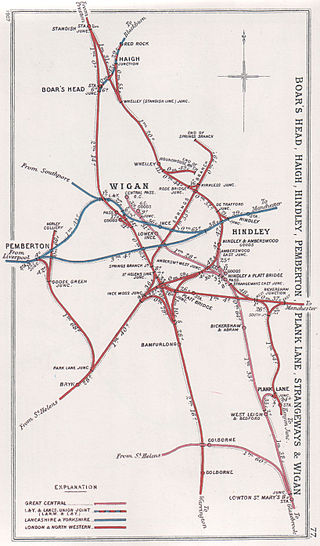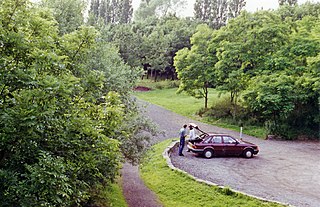
Newton-le-Willows is a market town in the Metropolitan Borough of St Helens, Merseyside, England. The population at the 2021 census was 24,642. Newton-le-Willows is on the eastern edge of St Helens, south of Wigan and north of Warrington, equidistant to Liverpool and Manchester.

Haydock is a village within the Metropolitan Borough of St Helens, in Merseyside, England. At the 2011 Census, it had a population of 11,416 Haydock's historic area covers the Haydock electoral ward and a section of the Blackbrook ward.

Wigan North Western railway station is one of two railway stations serving the town centre of Wigan, Greater Manchester, England.

Newton-le-Willows railway station is a railway station in the town of Newton-le-Willows, in the Metropolitan Borough of St Helens, and at the edge of the Merseytravel region. The station is branded Merseyrail. The station is situated on the northern route of the Liverpool to Manchester Line, the former Liverpool and Manchester Railway which opened in 1830. It is a busy feeder station for nearby towns which no longer have railway stations, such as Golborne, Billinge and Haydock. There is also a complimentary bus shuttle service to Haydock Park Racecourse on certain racedays.

Golborne is a town in the Metropolitan Borough of Wigan, in Greater Manchester, England. It lies 5 miles (8.0 km) south-southeast of Wigan, 6 miles (9.7 km) northeast of Warrington and 14 miles (22.5 km) to the west of the city of Manchester. Along with the neighbouring village of Lowton, it recorded a population of 24,041.

Lowton is a village within the Metropolitan Borough of Wigan, in Greater Manchester, England. It is around 2 miles (3 km) from Leigh, 7 miles (11 km) south of Wigan and 12 miles (19 km) west of Manchester city centre. The settlement lies across the A580 East Lancashire Road.
Ashton-in-Makerfield railway station was a railway station serving the town of Ashton-in-Makerfield, although it was located in the neighbouring village of Haydock, formerly in Lancashire, England.

The Wigan Junction Railways connected Glazebrook West Junction with the Lancashire Coalfields at Wigan.

The railway system in Wigan started development in the 19th century during the Industrial Revolution. The first railway built in the town was the Wigan Branch Railway which was opened on 3 September 1832 to serve the many collieries in the area; this was a branch line of the Liverpool and Manchester Railway, the first inter-city railway. By the turn of the 20th century, Wigan had numerous railway stations widely available across the borough, used by both freight and passengers. Many of the lines were originally built for freight which were later converted, as the owners saw the profitability of allowing passengers, to carry passenger trains.

Culcheth railway station served the village of Culcheth, Lancashire, England. It was west of the bridge where Wigshaw Lane crossed the railway.

St Helens Central (GCR) railway station served the town of St Helens, England with passenger traffic between 1900 and 1952 and goods traffic until 1965. It was the terminus of a branch line from Lowton St Mary's.
Haydock railway station served the village of Haydock, formerly in Lancashire, now in Merseyside, England.
Haydock Park railway station was a railway station adjacent to Haydock Park Racecourse, formerly in Lancashire and now in Merseyside, England. The station's sole purpose was to handle race day traffic. It did not feature in public timetables and normal service trains passed through the station without stopping.

Golborne North railway station served the town of Golborne, in the Metropolitan Borough of Wigan, Greater Manchester, England.
Golborne South railway station was one of two stations serving the town of Golborne, to the south of Wigan.
Lowton St Mary's railway station served the scattered community of Lowton, then in Lancashire, now in Greater Manchester, England. It was situated immediately south of the A572 bridge over the tracks.

Bickershaw and Abram railway station served the communities of Bickershaw and Abram southeast of Wigan, England.

Lowton railway station served the village named Town of Lowton to the east of Newton-le-Willows and south of Golborne.
The Wigan Branch Railway was a short-lived early British railway company, formed in 1830 and operating from 1832 to 1834 in Lancashire. It was constructed to link Wigan and the surrounding coalfield to the Liverpool and Manchester Railway (L&MR). It was involved in the first parliamentary approved amalgamation of railways to become part of the North Union Railway. Most of the line eventually became part of the West Coast Main Line (WCML).













